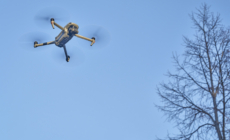-
Removing Carbon From the Sky Could Be the Next Climate Gold Rush - 7 mins ago
-
California’s rush to regulate AI has a 1st Amendment problem - 14 mins ago
-
Face of Shelter Dog Spending His Fourth Christmas Alone Breaks Hearts - 18 mins ago
-
The Enigma of Bob Dylan - 51 mins ago
-
Toddler’s Guilt Trip Works to Perfection on Grandma: ‘Caved In Too Quick’ - 53 mins ago
-
Newsom reads the election returns and heads to red California - 55 mins ago
-
‘SNL’ Takes on New Jersey Drones: ‘Dumb Theories’ - about 1 hour ago
-
A Woman With a Rare Gene Mutation Fights to Avoid Her Mother’s Fate - 2 hours ago
-
Newsom and a fellow Democrat spar over constitutional convention on gun control - 2 hours ago
-
Germany Christmas Market Latest: Suspect Remanded in Custody - 2 hours ago
US Faces Israel-Ukraine Dilemma – Newsweek
The Pentagon has said it will not deploy the same anti-ballistic missile defense system to protect Ukraine as it will to Israel, as the U.S. faces the growing problem of how to provide weapons for two escalating wars.
Washington has been the world’s biggest donor of military aid for Kyiv since Vladimir Putin invaded, but it faces a growing price tag for also helping Israel in the Middle East.
Israel is said to face a shortage of interceptor missiles and the Pentagon said Monday it would send the Terminal High-Altitude Area Defense (THAAD) battery to bolster its air defenses against Iran, which launched a missile attack on the country on October 1.

Handout from Lockheed Martin via Getty
Pentagon spokeswoman Sabrina Singh said Tuesday the idea that “different capabilities, different wars, different regions” was why the U.S. would not also deploy the THAAD system to Ukraine’s EU neighbors, such as Romania, to protect from Russian attacks.
It raises questions over whether Washington helping to close gaps in Israel’s protective shield against Tehran and its proxies could come at a cost for its support for Ukraine.
Former Deputy Assistant Secretary of Defense for the Middle East, Dana Stroul, has said that Washington “can’t continue supplying Ukraine and Israel at the same pace. We are reaching a tipping point,” The Financial Times reported.
“As the war in the Middle East escalates and there is still pressure to help arm Ukraine, and the Pentagon and its allies are pushing for a military budget of $1 trillion a year or more to deal with the perceived threat from China, they could well break the bank,” said William D. Hartung, a senior research fellow at the Quincy Institute for Responsible Statecraft.
“Interest on the debt is on track to be larger than the Pentagon budget by the end of this decade, and we have many, many unpredictable needs upcoming—disaster relief being just the most obvious,” he told Newsweek.

Getty Images
U.S. Aid for Ukraine vs. Israel
In the year following the Hamas attack on southern Israel on October 7, 2023, Washington’s spending on Israeli and related U.S. military operations in the region have reached $22.6 billion, according to the Costs of War project by Brown University’s Watson Institute for International Public Affairs in Rhode Island.
This is a conservative estimate which includes the $17.9 billion the U.S. government has approved in security assistance for Israeli military operations in Gaza and elsewhere since October 7, a figure “substantially more than in any other year since the U.S. began granting military aid to Israel in 1959.”
The U.S. Navy has scaled up its defensive and offensive operations against Houthi militants in Yemen, whose hostilities are partially related to Israel’s war in Gaza. It has also cost the maritime trade an additional $2.1 billion due to vessel diversions and higher insurance fees.
Meanwhile, since the start of the war in February 2022, Congress has voted through five bills worth around $175-billion of budget and humanitarian support for the government and Kyiv as well as weapons, the Council on Foreign Relations said last month.
Over the two and a half years of the war, President Joe Biden’s administration has loosened its restrictions of arms it initially feared would escalate the conflict, now providing long range ATACMS (Army Tactical Missile System) HIMAR (High Mobility Artillery Rocket System) and the green light for other countries to supply F-16 aircraft.
Democratic candidate Vice President Kamala Harris has indicated that U.S. military support for Kyiv would be maintained if she wins the presidential election in November, while her Republican rival, Donald Trump has cast doubt on whether this aid would continue.
“America has the resources. The question is not the availability of resources, but the willingness to deploy them, which is running out,” said Michael A. Witt, a professor of international business and strategy at King’s Business School, London.
“My hunch is that in the end, the United States will address this by leaning on Europe to foot more of the bill for Ukraine,” he told Newsweek. “The implication would then be that either the Europeans step up or Russia scores a major win.”
Israel’s Next Move
The THAAD battery that the U.S. has supplied Israel is designed to shoot down ballistic missile and sits alongside its Arrow system.
Despite weeks of bombardment, Lebanon-based Hezbollah has shown it can still strike at least 40 miles into Israel. On Sunday, a drone strike by the Tehran-backed militants killed four Israeli soldiers.
However, as Israeli Prime Minister Benjamin Netanyahu’s government plans a retaliatory strike for Iran’s barrage that Tehran said was to avenge the killing of Hamas and Hezbollah leaders, there are concerns further American involvement could be required in addition to the THAAD, as well as the U.S. troops sent to operate it.
“The Israelis know that if Iran responds to an Israeli attack, the Iranians will have to weigh whether or not to hit the important THAAD batteries and radars to have an effective counter-response,” said Matthew Hoh, associate director of the Eisenhower Media Network.
“The dilemma for the Iranians will be whether to carry out a ballistic-missile attack that may not be as effective due to the presence of this THAAD system or to target the THAAD system and risk giving cause for American strikes on Iran, ” he told Newsweek. “The U.S. troops in Israel, sent there quite publicly, create a trip wire.”
Source link

















